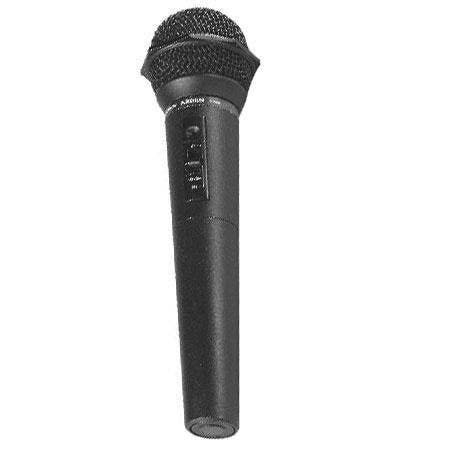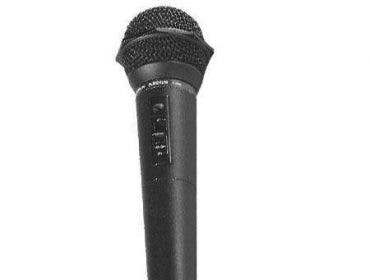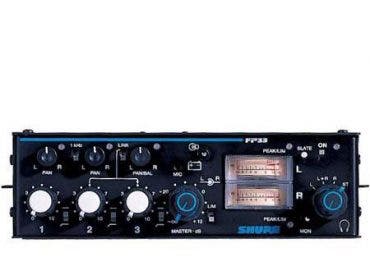Sound advice for HD video
Invest in a good microphone (or two) so your sound quality does justice to your DSLR’s HD video.
High-definition videos are a hot topic these days, thanks to a new generation of digital SLRs and advanced compact cameras that record HD videos. More and more still photographers and photojournalists are redefining themselves as multimedia professionals, recording moving images in addition to stills. But what about the sound? Does the quality of the audio that you’re capturing do those stunning videos justice? The secret is the microphone you are using.
Built-in Mics = Low-Definition Sound!
The chances that the microphone that’s built into your camera (even high-end models such as the Canon 5D Mark III, Nikon D800E, or any other camera available at the Adorama HDSLR department) will record high-quality sound are laughably small. If you’re serious about capturing good sound, you need a mic that isn’t built in.
The disadvantages of built-in mics:
• They are omnidirectional, so they pick up ambient sound.
• They faithfully record focus motors and camera-handling noise. Very distracting!
• They give you no control over what sounds will be recorded.
The advantages of built-in mics:
• They are built into the camera. It’s better than no sound at all, right?
So, what’s the alternative? If your camera has a microphone jack, you can attach any hand-held or off-camera microphone. If not, you’re out of luck. Keep this in mind when shopping for an HD Video-capable still camera!
There are many flavors of off-camera mics, and the Adorama Pro Audio department offers a wide selection including wired and wireless models, shotguns, omnidiretional, unidirectional and lapel mics. What are all of these things? Let’s dig deeper!
Editor’s note: All model availability and pricing is accurate as of August 2014.
Handheld Mic Buying Guide
Handheld microphones generally pick up sound in a unidirectional (it “focuses” on the sound source directly in front of it) or omnidirectional (it picks up sound from front and sides) pattern. The best kind for recording a person talking is a unidirectional, unless you are also trying to capture ambient sound.
Depending on the mic’s pick-up pattern, it may give the speaker a more exaggerated bass to his voice; this is known as Proximity Effect. While this can give radio talent a more authoritative-sounding voice, it sounds somewhat artificial to some ears.
Four handheld mic questions you should ask:
• Handling pick-up: Does it pick up handling noises, or is it damped against it?
• Is the sound pick-up protected against wind noise,“p” pops and sibilant “s” sounds? If not, you will also need to buy a wind sock.
• Is it rugged? If I drop it, will it still work?
• Wired or wireless? You pay more for wireless, but you don’t have to contend with connecting cables.
Three handheld mics to look at:
One of the popular manufactures in the handheld mic space is Anchor Audio and it has a range of offerings including the Anchor Audio MIC-90P that is designed to minimize noise while having technology that accentuates the tonal qualities of the human voice.
The Nady SPC-15 (right) is a good budget-priced, unidirectional condenser mic that’s designed especially for music and vocals, but it’s also fine for speaking and studio work.
If you don’t want to deal with wires, there are many wireless choices starting with some very inexpensive models. A good value is the Azden WM/T-Pro , which at around $115 at Adorama includes a built-in transmitter and operates on a single “AA” battery.
Choosing a Lavalier Microphone
One of the problems with hand-held microphones is that they have to be held. The subject has one hand available while the other is holding the mic. The mic might pick up handling sounds, which could ruin your video. One solution is the lavalier.
You’ve probably seen lavalier microphones on TV. These are itty-bitty thumb-sized microphones that are typically attached to a lapel, tie, or blouse. (The older versions used in the 60s were hung from a necklace.) Available both wired and wireless, they are designed to pick up the human voice clearly and with almost no ambient noise.
A wireless Lavelier consists of three pieces: The microphone itself, a transmitter (which the microphone plugs in to), and a receiver (which plugs into the camera). You can buy the components separately or together as a kit.
Three important questions:
• Is it waterproof? If you’re doing location shooting in rain, you don’t want to risk shock or water damage.
• Wired or wireless? As with handhelds, wired lavaliers are less expensive, but wireless allows for more freedom of movement.
• Does it pick up handling noise? While lavaliers are not hand-held, if you shift position or adjust your clothes, most will pick up some ruffling sounds, and it could be loud! Some models offer limited protection against such handling noise, but you may need to train your subject to sit or stand still and not rustle their fabric.
Two lavalier microphones to consider:
Considered the all-time best-selling wireless mics for videography, the Azden WMS-PRO 2 Microphone VHF Wireless Lavalier and Handheld Microphone System with WLT-PRO, WMT-PRO and WR-PRO includes a belt-pack transmitter, 2 plug-in electret condenser microphones, a lavalier and a handheld mic, and the WR-PRO receiver, which has a shoe mount
If you prefer a wired Lavalier, consider the inexpensive Nady LM-14U Unidirectional Lavalier, which has a mini-locking plug. (If your camera has a standard audio input outlet, you can buy a mini-to-standard adapter). For a look at all of the Lavalier microphones available at Adorama head here.
Camera-Mounted Microphones
The problem with hand-held mics and lavalier is that they appear in the picture, and require either a hard-wired connection or an expensive, cumbersome transmitter/receiver setup. While the ideal would be to have a mic that’s held separately by an audio specialist, most DSLR users who record videos fly solo.
That’s where camera-mounted mics come in.
No muss, no fuss, no wires!
Camera-mounted mics attach to the camera via the flash hot-shoe (in some cases, via an adaptor) and plug into the camera’s mic socket. Some of them are stereo (giving you a more accurate recording of the ambient sound), and some are mono shotgun-type microphones, which are the audio equivalent of telephoto lenses because they pick up a narrower field of sound. Switching between the two is like changing from a wide-angle to a telephoto lens.
When choosing an on-camera mic, look for low handling noise. Since the mic is mounted to the camera, it may pick up camera operation noises. Choose a mic that isn’t too physically long; otherwise, when you’re shooting with a wide-angle lens, it might show up in the top of the frame!
Three camera-mounted mics to consider:
The Rode Stereo VideoMic records true ambience via a stereo x/y condenser, and is said to produce broadcast sound quality. Many Canon 5D Mark II users I’ve spoken to are using this mic and are very pleased with the sound. A less expensive alternative is the Rode VideoMic, a shotgun mic that has impressed AdoramaTV’s Mark Wallace; watch his review in this video.
If you are on a tight budget, consider the Audio-Technica PRO 24 Stereo Camcorder Condenser Microphone, which comes with a camera mount and wind socket, and has an X-Y cardioid configuration that, according to A-T, provides realistic spatial effects. It’s well-built and designed for field use.
Off-Camera Mics
Off-camera mics that are neither hand-held nor lavaliers require a second person to hold them, either with a hand or some kind of boom that brings the mic closer to the speaker but (hopefully) out of the shot. These mics have a key advantage, which is that they don’t pick up camera operating noise, and can be aimed at an off-screen subject.
Off-camera mics tend to be shotgun-type microphones, which means they are unidirectional; in other words, they work much like telephoto lenses, with a limited angle of audio pick-up. They can be handheld or held via a boom.
Headphones Required
The person holding an off-camera mic should wear headphones and monitor the sound quality during the shoot. Because of its narrow sound pick-up field, you want to make sure you’re aiming it properly and the only way to know this is to listen as you record.
Three Off-Camera Mics to Consider:
The Azden SGM-990 Shotgun Microphone is low in cost but gives you the best of all worlds because it can change its pick-up pattern from omni-directional (picks up sounds from all around) to a narrower sound that reduces side noises. It comes with a windscreen and a camera mount.
The Sennheiser MKE 400 is a moderately-priced shotgun condenser mic that records in monaural. This is a good general-use mic for enthusiasts and professionals.
You will also need a Boom Pole and a good set of headphones; Adorama’s Headphones department has an extensive selection.
Don’t have a mic jack? All is not lost!
If your camera lacks a mic jack (or mini-jack), you’re not out of luck—but you will need some additional gear. There are two alternatives:
1. Record audio simultaneously on a separate recorder and mic, and sync the sound to the video in post-production. Use a high-end audio recorder, such as the Zoom H4n Handy Mobie 4-track recorder and any microphone mentioned in this article as you are recording the video. Use a clapper (or simply clap your hand once) at the beginning of the video so you have a unique sound that will be captured by both the camera’s onboard mic and the sound recorder so you can easily sync the sound in post-production. Watch this video, where Richard Harrington explains how to do it.
2: Record voice-overs and other overlay sound in post-production using a USB microphone that’s attached to your computer.
Producing voice-overs in a controlled studio (or at least, a very quiet environment) will give you high-quality sound and control. In software, you can edit out the “ums” and “uhs” that typically occur and better match narration to a scene, and cut and paste sections of sound at will.
You can even record a voice-over right into your computer, using USB microphones. These mics are relatively inexpensive and simple to use in conjunction with audio and/or video editing software, which is available at Adorama. They don’t require any additional pre-amps or mixing boards.
3 USB Microphones To Consider:
The Samson Meteor Large Diaphragm USB Studio Microphone designed for use be by podcasters, musicians, singers or anyone in need of a quality microphone for recording audio directly to Windows or Mac OS software, and has the added bonus that it needs no additional drivers to run with the software. It comes with an integrated tripod base and has an integrated headphone jack.
At under $30 it’s hard to go wrong with the Logitech ClearChat stereo headset with noise-cancelling mic. While this is primarily designed for use with Skype and similar services, it could also be used to record voice overs as long as you don’t mind sounding a little like an operator.
MXL makes a range of USB mics, but the top of the line is the MXL USB.009, which records in a more tonally rich 24 bit/9kHz without needing expensive equipment. Sound quality can be adjusted on the mic via three rotary knobs, while the mic itself offers specs that rival traditional studio mics. Consider this one if you’re serious about sound. (You will need to buy a stand and headphone separately.)
You will also need a good pair of headphones.


